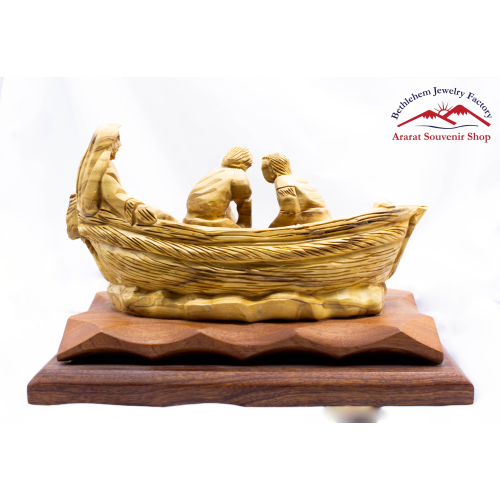



Anthimus of Nicomedia Icon
1,520 $
Anthimus of Nicomedia Icon
Product specifications:
- Delivery is available within 15 days
- Bethlehem Jewelry Factory Holy Land, Israel
-
Material: Olive wood
Weight : 2.4LB (1112gr)
Length: 12 inches (300mm)
Width: 5.5 inches (240mm)
Height: 1 inches (20mm)
- Resizable: No
- Made in the Holy Land
Anthimus of Nicomedia Icon
Saint Anthimus of Nicomedia, a prominent figure in early Christianity, is venerated for his steadfast faith and commitment during a time of intense persecution. His iconography is rich in symbolism and historical context, reflecting his role as a bishop and martyr. This icon often depicts him in a dignified manner, adorned in episcopal robes, symbolizing his authority and spiritual leadership within the Church. Typically, Anthimus is shown holding a cross or a Gospel book, which signifies his role as a preacher of the Word of God and his deep commitment to the Christian faith.
Anthimus was the bishop of Nicomedia, an important city in Bithynia (modern-day Turkey), during the late 3rd century. His life and martyrdom occurred during the reign of Emperor Diocletian, a period notorious for its severe persecution of Christians. According to tradition, Anthimus boldly defended the Christian faith against pagan practices and idolatry, encouraging his flock to remain steadfast in their belief. His unwavering resolve led him to confront the authorities, ultimately resulting in his arrest and martyrdom. The icon not only tells the story of his life but serves as a reminder of the courage required to uphold one’s convictions against persecution.
In many depictions of Saint Anthimus, his facial expression reflects serenity and determination, despite the suffering he endured. This portrayal serves to inspire believers, reminding them that true faith often requires sacrifice and perseverance. The background of the icon may feature elements that underscore the themes of divine protection and grace. Some icons depict a radiant light or heavenly atmosphere surrounding him, illustrating the belief that he was enveloped in God’s glory, especially at the moment of his martyrdom. These visual elements enhance the icon’s spiritual significance, drawing the viewer into a deeper contemplation of faith, sacrifice, and divine assistance.
Moreover, the icon of Saint Anthimus frequently includes stylized depictions of martyrdom, which may feature instruments of his execution or visions of angels. These elements not only provide historical context but also evoke a deeper understanding of his legacy within the Church. The presence of angels in the icon suggests the belief that he was escorted by divine beings to heaven upon his death, affirming his status as a saint. This aspect of his iconography contributes to the overarching theme of hope and eternal life that is central to Christian belief.
The color palette utilized in the icon of Saint Anthimus also carries significant meaning. Traditionally, the use of gold symbolizes divinity and the heavenly realm, while red may represent martyrdom and sacrifice. The juxtaposition of these colors reinforces the notion of Anthimus as a holy figure who transcended earthly challenges through his faith. His garments, often rendered in rich, deep colors, reflect the solemnity of his office as a bishop and signify his importance in the Church.
The cult of Saint Anthimus flourished in the Byzantine Empire, where he was celebrated for his virtues and martyrdom. His icon was not only a form of veneration but also served as an educational tool for the faithful. Icons in the Eastern Orthodox tradition are often used as a means of catechesis, teaching believers about significant events and figures in Christianity. The life of Saint Anthimus, illustrated through his icon, served to fortify the faith of early Christians and encourage them to emulate his courage and devotion amidst trials.
In the broader context of church history, Anthimus stands as a figure who represents the struggle of early Christians against relentless persecution. His life reminds believers of the importance of standing firm in faith, even in the face of adversity. The icon thus becomes a touchstone for reflection on personal convictions and the commitment to the teachings of Christ in one’s own life.
Saint Anthimus of Nicomedia’s legacy continues to thrive in the Christian community, particularly among the Orthodox faithful. His feast day, celebrated on September 3, is an occasion for believers to reflect on his life and the ideals he embodied. Many churches may feature his icon prominently, serving as a source of inspiration and a call to emulate his faithfulness.
In conclusion, the icon of Saint Anthimus of Nicomedia encapsulates not only the historical significance of the saint but also offers rich theological insights into the nature of martyrdom, faith, and perseverance. Through its vibrant imagery and symbolic elements, the icon invites believers to contemplate the dynamics of divine grace, the nature of sacrificial love, and the eternal hope afforded to those who remain steadfast in their faith. As such, the icon serves both as an artistic portrayal and a spiritual beacon, guiding Christians toward a deeper understanding of their faith and encouraging them to embrace the virtues exemplified by Saint Anthimus.









Reviews
There are no reviews yet.